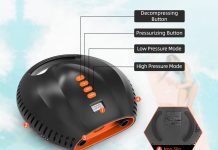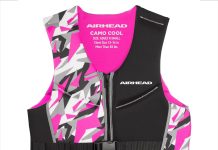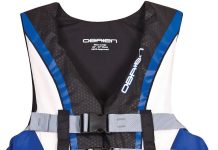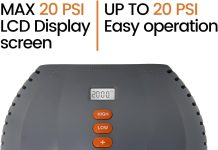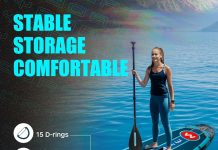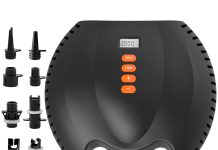Have you ever wondered where the leash should be on a SUP board? It’s a question that many paddleboard enthusiasts often find themselves asking.
Whether you’re a beginner or a seasoned pro, understanding the proper placement of your leash can make all the difference in ensuring a safe and enjoyable experience on the water.
In this article, we’ll explore the different options and factors to consider when deciding where to attach your leash on a SUP board. So, let’s dive in and discover the best spot for securing your leash, allowing you to paddle with peace of mind.
Introduction
Safety should always be a top priority when it comes to stand-up paddleboarding (SUP). One essential safety measure is using a leash to connect you to your board. But where exactly should the leash be attached on a SUP board? This article will discuss the various factors to consider and explore the pros and cons of different attachment points. By understanding these factors, you can make an informed decision and choose the right leash attachment point for your SUP adventures.
Factors to Consider
Board Type
The type of board you use is an essential factor to consider when determining where to attach your leash. There are two main types of SUP boards: rigid boards and inflatable boards. Rigid boards are made of solid materials like fiberglass or carbon fiber, while inflatable boards are made of durable PVC.
It is recommended to attach the leash to the board’s tail for rigid boards. This attachment point offers optimal control and maneuverability, especially in rougher conditions. On the other hand, inflatable boards often have dedicated attachment points explicitly designed for leash attachment. These attachment points are typically located near the tail or on the sides of the board, providing a secure connection without compromising stability.
Conditions
The conditions in which you will be paddleboarding also play a crucial role in determining the ideal leash attachment point. If you are planning to paddle in calm and flat water, attaching the leash to the tail of the board or the designated attachment points should be sufficient. However, if you are venturing into more challenging conditions, such as strong currents or big waves, attaching the leash to your ankle or calf might be a better option.
Paddle Style
Your paddle style can also influence the choice of leash attachment point. If you prefer a traditional paddling style, where your hands remain close to the center of the board, attaching the leash to the tail or designated attachment points is recommended. This attachment point allows for fluid strokes and unrestricted movement.
However, if you practice a more aggressive or dynamic paddle technique, such as racing or surfing, attaching the leash to your ankle or calf may be preferable. This attachment point provides enhanced control and prevents the leash from interfering with your paddle strokes.
Leash Attachment Points
Ankle Leash Attachment
Attaching the leash to your ankle is a popular attachment point choice for many paddleboarders. This attachment provides a closer connection to the board, ensuring it stays within reach even in challenging conditions. The ankle attachment is also less likely to become entangled with the paddle or board during falls or wipeouts, minimizing the risk of injuries.
Calf Leash Attachment
The calf attachment point is another option worth considering. It offers similar benefits to the ankle attachment, including a secure connection to the board and decreased risk of entanglement. The calf attachment point provides slightly more mobility than the ankle attachment, allowing for more significant leg movement. This can be advantageous for paddlers who require a more comprehensive range of motion or participate in SUP activities that demand quick footwork.
Knee Leash Attachment
The knee attachment point is less common but can be suitable for specific situations. Attaching the leash to your knee gives you the advantage of even greater mobility and leg movement. This attachment point is often used by paddleboarders who engage in SUP yoga or other activities that involve a significant amount of kneeling or sitting on the board. However, it is essential to note that the knee attachment point may not provide the same security and control as the ankle or calf attachments in more demanding conditions.
Pros and Cons of Different Attachment Points
Ankle Leash Pros
- Provides a close and secure connection to the board.
- Minimizes the risk of entanglement during falls or wipeouts.
- Allows for freedom of movement and comfortable paddling.
Ankle Leash Cons
- It may restrict leg movement in specific paddle techniques.
- It may cause discomfort or rubbing on the ankle during long sessions.
Calf Leash Pros
- Offers a secure connection to the board.
- Provides enhanced mobility and leg movement.
- Reduces the risk of entanglement.
Calf Leash Cons
- It might require adjustments to find the optimal attachment point.
- It may cause discomfort or rubbing on the calf for some individuals.
Knee Leash Pros
- Provides maximum leg mobility and range of motion.
- Suitable for activities involving kneeling or sitting on the board.
Knee Leash Cons
- It may not offer the same level of security and control as ankle or calf attachments.
- It is not recommended for more challenging conditions or aggressive paddling techniques.
Personal Preference and Comfort
Ultimately, the choice of leash attachment point comes down to personal preference and comfort. Some paddleboarders may have specific needs or preferences based on their body type, experience level, or the type of SUP activities they engage in. It’s essential to try different attachment points and evaluate how they feel and perform in various conditions. By experimenting and listening to your body, you’ll be able to find the attachment point that best suits your individual needs.
Choosing the Right Leash
Apart from the attachment point, other factors should be considered when selecting a leash for your SUP board. These factors include leash length, leash thickness, and the presence of a leash swivel.
Leash Length
The paddling should determine the length of your leash you plan to do and the conditions in which you’ll be paddleboarding. A shorter leash length of around 8-10 feet is often sufficient for flatwater paddling or shorter boards. However, a longer leash length of 10-12 feet may be more appropriate for open ocean paddling or longer boards. Choosing a leash length that allows you to maneuver while keeping you connected to your board comfortably is essential.
Leash Thickness
Leash thickness is another factor to consider, as it can affect the overall performance and durability of the leash. Thicker leashes are generally more durable and suitable for more challenging conditions or heavy surf. Thinner leashes, on the other hand, provide less drag and can be more comfortable for general paddling. Finding the right balance between durability and comfort is essential based on your specific paddleboarding needs.
Leash Swivel
A leash swivel is a rotating device between the leash cord and the ankle/calf strap. This swivel allows the leash to rotate freely, preventing it from twisting or tangling around your legs. A leash with a swivel is particularly beneficial for paddleboarding activities that involve a lot of turning or quick directional changes. It ensures the leash doesn’t interfere with your movements, providing a more enjoyable and hassle-free paddling experience.
Safety Considerations
While a leash is essential for keeping you connected to your board, it’s important to consider safety mechanisms in emergencies or entanglements.
Leash Release Mechanisms
Some leashes have quick-release mechanisms that allow you to detach from your board in emergencies. These mechanisms are fundamental in challenging conditions where quickly separating from your board can prevent accidents or injuries. It’s worth investing in a leash with a reliable release mechanism to ensure your safety on the water.
Leash Placement for Safety
Regardless of the attachment point or type of leash, it’s essential to position the leash away from your body, especially your neck. This prevents the leash from getting tangled or wrapped around your neck in case of falls or wipeouts. Secure the leash firmly around your ankle, calf, or knee, ensuring it is comfortable and doesn’t restrict blood flow. By following these safety guidelines, you can enjoy paddleboarding with confidence and peace of mind.
Conclusion
Determining where to attach the leash on your SUP board is essential, considering factors such as board type, conditions, and paddle style.
You can select the option that best suits your needs and preferences by weighing the pros and cons of different attachment points. Additionally, choosing the right leash length, thickness, and swivel will further enhance your paddleboarding experience.
Above all, prioritize safety by selecting a leash with reliable release mechanisms and ensuring proper placement. With these considerations in mind, you can enjoy your SUP adventures while staying connected to your board safely and securely.


